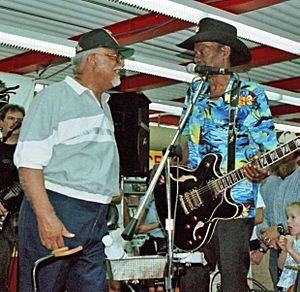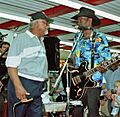Wardell Quezergue facts for kids
Quick facts for kids
Wardell Quezergue, Sr.
|
|
|---|---|

Quezergue (left) greeting Clarence "Gatemouth" Brown, New Orleans, 1997
|
|
| Background information | |
| Birth name | Wardell Joseph Quezergue |
| Born | March 12, 1930 New Orleans, Louisiana |
| Died | September 6, 2011 (aged 81) New Orleans, Louisiana |
| Genres | Jazz, rhythm and blues, blues, big band, classical |
| Occupation(s) | Composer, producer, arranger, conductor, bandleader |
| Years active | 1940s–2011 |
| Labels | Nola, Malaco, and others |
Wardell Joseph Quezergue (KƏ-zair; March 12, 1930 – September 6, 2011) was an American composer, arranger, and record producer. He was also a bandleader. Musicians in New Orleans called him the "Creole Beethoven." He was a very important musician whose work shaped the sound of New Orleans rhythm and blues, funk, and pop music. He helped many other artists become famous. He was a big part of the New Orleans music scene.
Contents
Early Life and Musical Beginnings
Quezergue was born in the Seventh Ward of New Orleans. He came from a musical family. His father, Sidney Quezergue Sr., played guitar. His mother, Violetta Guimont, played clarinet. His older brothers, Sidney Jr. and Leo, were jazz musicians. The family often played music together on Sundays.
Wardell did not have formal music lessons. He learned by listening to and playing with his family. He was inspired by famous jazz musicians like Louis Armstrong and Dizzy Gillespie. As a teenager, he played the trumpet professionally. He also started to compose his own music.
Wardell's Musical Journey
Early Career: 1940s–1950s
In the late 1940s, Quezergue played in Dave Bartholomew's band. In 1951, he joined the army. He served as an army musician in Japan during the Korean War. He said the army and its musicians taught him a lot about music. While in Japan, he met and married his wife, Yoshi Tamaki.
After returning to New Orleans, he studied at the Gateway School of Music. He started getting jobs by rearranging popular songs for local musicians. In the mid-1950s, he became a bandleader. His bands were called the Royal Dukes of Rhythm and later Wardell and the Sultans. He taught music and arranged for well-known artists like Otis Redding. He was also a member of the New Orleans Negro Musicians Union.
Quezergue did not have one special musical style. He treated each song and project differently. He avoided listening to hit songs on the radio. He thought it might stop him from being creative. When he didn't have a piano, he used a tuning fork to find the right pitch. When arranging music, he always thought about the bassline first. He believed the bassline gave the music its "groove" and energy. He was especially good at arranging music for horn sections. He said his job was to mix New Orleans jazz with other types of music.
Hits and Success: 1960s–1970s
In the early 1960s, Quezergue arranged music for Dave Bartholomew at Imperial Records. He worked on songs by Fats Domino and Earl King. He also worked on King's famous song "Trick Bag." He arranged Professor Longhair's popular carnival song "Big Chief." He also arranged music for Motown artists like Stevie Wonder.
In 1962, Quezergue started his own record label called Nola Records. In 1964, he helped write "It Ain't My Fault." This instrumental song became a New Orleans funk classic. Robert Parker's song "Barefootin'" from Nola Records reached number two on the R&B chart. Other artists on his label included Eddie Bo and Willie Tee.
Later, he worked with Malaco Records in Mississippi. In just one week, he recorded King Floyd's "Groove Me" and Jean Knight's "Mr. Big Stuff." Both songs became number one hits on the R&B chart. Big record labels like Stax and Atlantic first said these songs wouldn't be popular. So, Malaco released "Groove Me" on its own label. It became King Floyd's biggest hit. Many artists, from Etta James to Tom Petty, have covered it. Stax eventually released "Mr. Big Stuff." It became their best-selling song ever, selling more than two million copies. It sold more than songs by Otis Redding and Sam and Dave.
Quezergue also arranged two songs for The Dixie Cups: "Iko Iko" and "Chapel of Love." "Chapel of Love" reached number one on the Pop chart. By this time, Quezergue was so important in New Orleans music. He even turned down a big offer to join Atlantic Records.
Because of his success, many artists wanted to work with Quezergue and the Malaco studio in the 1970s. Artists like Paul Simon, Willie Nelson, and B.B. King used his skills. In 1975, he arranged Dorothy Moore's "Misty Blue." This song became a hit on the Pop chart, reaching number three. He also worked with G. C. Cameron, the former lead singer of the Spinners, and the Pointer Sisters.
Later Years: 1980s–2010s
In the 1980s, Quezergue worked with the Neville brothers. In 1992, he produced and arranged Dr. John's album Goin' Back to New Orleans. This album won a Grammy Award. In the late 1990s, he arranged horn music for two big band albums by Clarence "Gatemouth" Brown.
In 2000, he released a classical music piece called A Creole Mass. This music honored a soldier who took his place in combat during the Korean War. In 2003, Quezergue produced an album for singer Will Porter called Happy. This album was named the best-produced CD of the year by the New York Blues & Jazz Society.
In 2005, Quezergue lost his belongings and music scores because of Hurricane Katrina. The next year, benefit concerts were held to help him. Dr. John and other musicians like REM's Mike Mills helped out.
In 2009, Quezergue received an honorary doctorate in music. This was from Loyola University New Orleans. It was for his dedication to public service and the arts. He was known for helping others' careers, teaching, and creating New Orleans' special horn sound. The same year, a tribute concert for him was held at Lincoln Center in New York. A nine-piece band from New Orleans played with Dr. John, Robert Parker, Jean Knight, and the Dixie Cups. Even though he was older, Quezergue conducted the concert. Also in 2009, he released an album called Music for Children Ages 3 to 103. The Jazz Foundation of America helped fund this album.
In 2010, Quezergue was added to the Louisiana Music Hall of Fame. In 2011, he finished two more musical works. One was a classical piece called The Passion. It was about the religious idea of resurrection. He worked on it for two years. In August 2011, he approved the final mixes for Will Porter's album Tick Tock Tick. This album featured Dr. John and Bettye LaVette.
Death
Wardell Quezergue passed away on September 6, 2011, in New Orleans. He was 81 years old. His wife of 60 years, Yoshi Tamaki, had passed away earlier in May 2011. They had eight daughters and five sons. His son Brian Quezergue is a bassist.
Classical Compositions
- A Creole Mass – This piece was first performed and recorded at St. Louis Cathedral in 2000.
- The Passion, Death, and Resurrection of Jesus Christ – This piece was first performed and recorded at Corpus Christi-Epiphany Church in 2013.
Images for kids
-
Quezergue (left) greeting Clarence "Gatemouth" Brown, New Orleans, 1997


